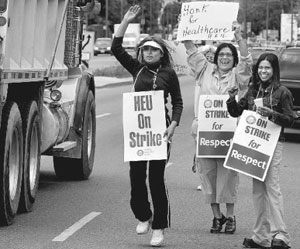
Labour Day? At The Tyee this will be Labour Week, with labour-related special features running today through Friday. And that's just a start for increased labour coverage in the coming months, building as we go an occasional series we're calling Working Ahead: Labour in a New Era of Challenges.
We begin with the first of a two-parter, growing out of weeks spent interviewing union officers and staff, heads of local labour councils, rank-and-file members, union-side labour lawyers, employer spokespeople and academic experts. They were asked to help us identify the decade's 10 most significant B.C. labour stories. Here are the first five, with the rest to run tomorrow, along with a diversity of voices weighing in.
1. The Changing Face of B.C. Labour
In 1983, the percentage of B.C.'s work force in a union (a measure called union density) was at 45.3 per cent while by 2007 it had fallen to around 31 per cent, according to StatsCanada.
Nationally, in 1983 the density figure was 35.7 per cent and in 2007, 30.03 per cent. In 2009, union density fell slightly in B.C. Union density has grown in the public sector and fallen in the private sector in Canada and in B.C., but not so dramatically as in the U.S.
In 2009, the Canadian public sector was 71.3 per cent unionized, while the private sector was only 16.1 per cent. In the U.S., the comparative figures were 7.6 per cent in the private sector and 36.8 per cent in the public sector. While the prototypical unionized worker in B.C. in the 1960s was a white, male logger or mill worker, now the face of labour is much more likely to be a visible minority woman who works in a hospital or government office.
Think of it as the Revenge of Rosie the Riveter. (Rosie was the iconic WW II figure who embodied women's entry into the factory work force during the war, and their being driven back out afterwards. Now she's back and often serving as a union president or shop steward.)
2. I'll See You in Court
It's nearly unanimous. Almost every source The Tyee consulted agreed that Bill 29, the notorious union-busting legislation passed in 2002, was among the decade's top stories, especially when taken together with the precedent-setting judgment by the Supreme Court of Canada in 2007 that struck down some of its key provisions and established free collective bargaining as a charter-protected right.
Despite this huge win for organized labour, sources tell The Tyee, the unions representing B.C. health-care workers face almost weekly challenges as government and employers in the sector take advantage of the provisions of Bill 29 that survived Supreme Court review to privatize and contract out services.
3. Health, Safety and Lethal Workplaces
A list of tragedies prompting criticism of government policies begins with the Sullivan Mine disaster. Between May 15 and 17, 2006, two workers, Doug Erickson and Bob Newcombe, and two B.C. Ambulance paramedics, Kim Weitzel and Shawn Currier, died at Teck Cominco's decommissioned Sullivan Mine site near Cranbrook. They were felled by oxygen-depleted atmosphere inside the tiny water-monitoring structure build over a tailings dump. The tragedy posed serious questions about whether the province adequately regulates mine safety and situations in which workers are isolated on the job site. (Find extensive Tyee coverage here.)
In 2005, Grant De Patie was killed by a drunken teenager driving a stolen car. Grant was dragged to his death in an attempt to stop a "gas and dash" theft at the station where he worked. In 2007, with much fanfare, the provincial government unveiled a new piece of legislation, "Grant's Law," which required pre-payment for nighttime gas purchases, but has, to date, reportedly because of retail-industry lobbying, failed to move on more significant reforms that were also called for, including safety barriers for night workers or mandatory double staffing over the night shift.
Grant's father Doug told The Tyee last year that: "The government is just catering to businessmen. Employers weren't doing anything to prevent gas-and-dash crime, or the dangers it posed to people like Grant working alone overnight. We need even stronger laws, not weaker."
Deaths associated with farm work were big news this decade, with three men killed and another two severely disabled working in an enclosed space on a Langley mushroom farm in 2007 and three women killed while another 13 were injured when an overloaded and under-equipped van belonging to a farm labour contractor flipped over on a rainy highway outside Chilliwack in 2007.
On Aug. 31, 29 charges were laid under worker-safety legislation against two companies and several company owners and directors for offenses connected wih the mushroom farm deaths. In contrast this April, the provincial government declined to implement almost all the 18 safety-for-farm-worker policies recommended by a coroner's jury investigating the 2007 highway deaths.)
By contrast, calls for inquests to mounting logging-industry deaths in the early part of the decade went unheeded by the provincial government. Critics argued that deregulation under the BC Liberal government had created conditions for more risky practices, leading to a string of deadly tragedies in the forests and on logging roads.
4. Changing the Rules, Moving the Goal Posts
Perhaps the biggest and most consequential labour story of the decade in B.C., many of our sources agreed, was transformation by the Campbell Liberals of the basic regulatory bodies that govern labour and labour relations in the province. Rules embodied in the Labour Relations Code and administered through the Labour Relations Board have been revised to make it much harder for new union certifications to be won, with the numbers of new workers organized into unions plummeting from an annual average of more than 8,000 during the 1990s to less than 2,000 a year in the first three full years under the new business-friendly LRB of the 2000s.
Employment Standards Act changes brought in early in the Campbell years excluded many workers from the act's protection altogether, closed offices, almost totally deregulated work by children between 12 and 15, cut the minimum shift from four to two hours, made it harder for workers to get vacation and overtime pay from their employers and obligated workers who experience employer abuse of ESA protections to conduct their own cumbersome and daunting "do-it-yourself" complaint procedures.
And if you are injured at work in B.C., changes brought in during this decade mean that you are likely to qualify for much less compensation than you would have in the 1990s, only one element in a series of changes that critics say make Worksafe BC a much less effective support for injured workers than in times past. (Later this week in another of our Labour Week features, The Tyee will examine in detail the changes made at Worksafe BC and what those changes mean for injured workers. The news on this front is increasingly grim.)
The decade also saw a major revamping of trades training and apprenticeship programs, changes that mean far fewer young B.C. workers are getting the training they need to qualify as journeymen/women in their trades. A source within the building trades referred to this phenomenon as the "de-skilling" of the construction sector.
5. Chump Change
B.C. now has the lowest minimum wage standard in Canada, which allows employers to pay $8 an hour for many low wage workers and provides permission to pay an even lower $6 an hour training wage. These extremely low standards have been the target for ongoing campaigns by the labour movement, including the "Six Bucks Sucks" initiative.
One of the good news stories for B.C. labour this decade has been advances made in the campaign to get the province's employers to commit to paying at least the "living wage." The campaign got a boost in April of 2010 when the City of New Westminster took steps to guarantee that all city employees and all hired by city contractors were paid at least $18.17 an hour, the living wage figure computed by the campaign, which has been actively promoted by unions across the province and the Canadian Centre for Policy Alternatives, a progressive think tank.
Partly as a result of policies linked to the persistence of relatively low wages, child poverty continues to be a major labour story, with B.C. ranking as the province with the highest levels in Canada each year since 2002, and more than half of the children living in poverty experiencing that deprivation despite the fact that one or more of their parents have full time work.
Tomorrow: Temporary foreign workers rise, unions merge and battle each other, business leaders sing of peace and various voices weigh in. ![]()
Read more: Rights + Justice, Politics, Labour + Industry















Tyee Commenting Guidelines
Comments that violate guidelines risk being deleted, and violations may result in a temporary or permanent user ban. Maintain the spirit of good conversation to stay in the discussion.
*Please note The Tyee is not a forum for spreading misinformation about COVID-19, denying its existence or minimizing its risk to public health.
Do:
Do not: